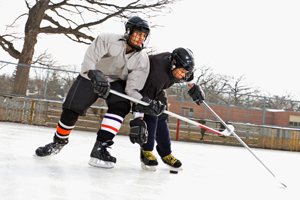Groin pain is a common complaint among athletes. It’s involved in 5 to 20 percent of all sports injuries to athletes, but diagnosing it may be a challenge.
A long list of groin injuries share similar symptoms. Athletes often are given a diagnosis of groin strain and told to rest. Rest is sufficient treatment for some, but if the groin pain doesn’t resolve in a reasonable time, it may be a sports hernia.
 A sports hernia is not the same as the more common inguinal hernia caused when an actual separation or hole occurs in the abdominal wall allowing a visible bulge to appear. A sports hernia occurs when a weakening or thinning of the abdominal wall causes pain and dysfunction during sports-specific movements.
A sports hernia is not the same as the more common inguinal hernia caused when an actual separation or hole occurs in the abdominal wall allowing a visible bulge to appear. A sports hernia occurs when a weakening or thinning of the abdominal wall causes pain and dysfunction during sports-specific movements.
Sports hernias occur in men and women, and most commonly among competitive athletes in football, hockey, soccer, tennis and weightlifting. Weekend warriors and athletes making extreme and repeated twisting and turning movements also are susceptible to sports hernias.
Effective treatment of sports hernias begins with a thorough examination by a medical provider familiar with diagnosing and treating sports-specific groin injuries. Your provider may ask you:
- What were you doing when you were injured?
- Where is your pain located?
- What makes the pain better and/or worse?
Sports hernias can occur during aggressive turning and twisting movements while playing sports. Sudden groin pain in the low abdomen and upper inner leg can result. The pain typically improves with rest and anti-inflammatory medications such as ibuprofen, but can recur when you resume activity.
Chronic groin pain diagnosed as a sports hernia may be treated by:
- Resting
- Changing the activity
- Doing an extended course of rehabilitation
If you can’t return to your sport without groin pain, sports hernia surgery may be necessary. Outpatient surgery repairs affect muscles and tendons. A thin surgical mesh is often applied during the surgery to give support. Following surgery, most athletes can return to play in four to six weeks, or eight to 10 weeks if rehab is required.
Successful treatment and recovery begins with recognizing the commonly missed signs and symptoms of sports hernia. With proper initial care, treatment and rehab, you can return from suffering a sports hernia to enjoy your sport and fitness activities safely and pain free.
Share comments or questions on this information email: sports.medicine@marshfieldclinic.org.
